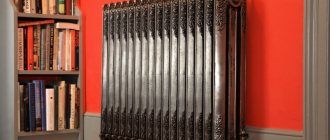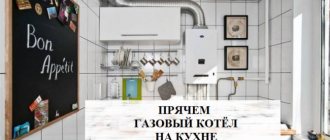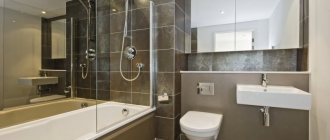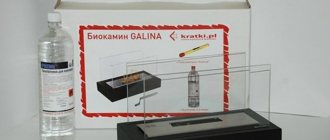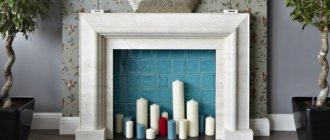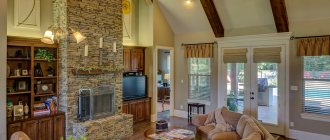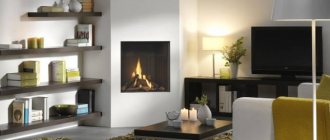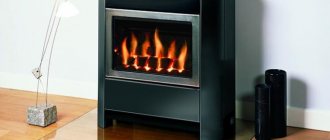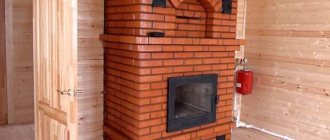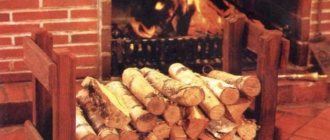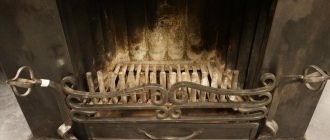Today, a fireplace rarely acts as a heating element, as was customary in the old days. Of course, it can make you warmer and more comfortable, but its main purpose in a private house or city apartment is decorative. The living room immediately acquires the features of luxury and nobility. Sitting by a heat source with a cup of coffee on winter evenings, or simply after a hard day at work, you can relax and not think about anything, or just watch TV.
The range of modern models includes a large number of all kinds of classic and original options. One of the most popular is a corner fireplace in the interior.
Types of fireplaces
Depending on the type of fuel, installation method, style and location, models come in different types: wood-burning, gas, electric, floor-mounted, wall-mounted, straight, corner, stone, timber. There are devices that don't even need a chimney. They do not emit harmful substances into the atmosphere, although they function on the principle of living fire.
Built-in options take up little space, but the space for them should be taken into account in advance when designing the interior so as not to disturb the structure of the walls. If you decide to install equipment after renovation, the best option is a wall-mounted fireplace. As for the exterior decoration, it can be made of stone, brick, and other materials.
In addition to the above, island and corner fireplaces are popular - they fit organically into the interior, becoming an integral part of it.
Chimney installation
Those who believe that the chimney is just a direct channel for the exit of flue gases should take a closer look at the diagram and order of the chimney, which experts recommend for equipping wood-burning stoves. Inside, it really is a hollow tube of rectangular cross-section. As for the outer part, its configuration serves an important functional purpose.
Design and arrangement of the chimney
The thickening at the intersection with the ceiling is called fluff. Thanks to several additional rows of bricks, it is possible to reduce the temperature of the flue gases so much that there is no need to install a heat-insulating layer. If you install a straight, thin riser, then the ceiling will have to be protected with several layers of asbestos or basalt slabs.
At the roof level, the chimney is expanded, resulting in a so-called otter. In addition to its aesthetic purpose, such widening also plays another, no less important role. When it rains, it is the otter that prevents precipitation from flowing down the outer surface of the riser, protecting the brick from destruction. As for protecting the smoke channel, for these purposes the top of the pipe is crowned with a metal cap.
Otherwise, when constructing fireplace chimneys, you must be guided by the same requirements as for other wood-burning stoves. The traction force, and therefore the performance of the fireplace, depends on the correct placement of the structure on the roof. You can familiarize yourself with the rules for installing a chimney by carefully studying the diagram below.
Chimney installation diagram relative to the ridge and roof of the building
Design and benefits
The advantages of corner models are undeniable. The main one is significant savings in free space. Being in the corner, the fireplace does not disturb anyone, and at the same time fulfills all its practical and decorative functions in full. The chimney in this design is located in any of the walls.
By their design, corner fireplaces are very compact; they can be installed not only in a large living room, but also in rooms with a small area - for example, in a bedroom or in an office. Due to its location between two walls, this design also heats adjacent rooms, which is also very convenient and practical. Corner models can be symmetrical or asymmetrical.
Approximate cost
The cost of a corner fireplace for a living room is determined by its parameters, the area of the heated room, finishing materials and the manufacturer.
The price range is quite wide:
- Corner models made of brick - 80-160 thousand rubles.
- Systems finished with natural stone (onyx, marble, granite) – 150-250 thousand rubles.
- Fireplaces made of soapstone - about 230 thousand rubles.
- Estoril corner fireplaces – from 150 thousand rubles.
- Portable wood-burning modifications – 15 thousand rubles.
Asymmetrical fireplaces
These models have a clearly rectangular shape and are mounted directly into the corner. Thus, space is saved and the fireplace fits clearly even into an interior where such equipment is not provided. The chimney can also be easily installed into an adjacent wall.
An asymmetrical fireplace is often used as a unique element for zoning a room. Much in the perception of the overall interior depends on the cladding and external design of the fireplace, but these are questions for professional designers. If you wish, you can look at the photo and choose the best option.
Execution of cladding
Cladding a false fireplace with decorative stone
Externally, the brick fireplace structure looks inconspicuous. To give the building a beautiful look, you can:
- Plaster the surface. The plaster mortar is applied after 14 days - wet bricks can cause it to crack after drying. It is allowed to paint the plaster layer with fire-resistant paints.
- Perform cladding. Artificial or natural stone looks beautiful. The ability of the material to tolerate temperature fluctuations and accumulate heat will provide a comfortable microclimate. To create a drawing, you should be inspired by a beautiful photo.
- Secure the gypsum board. Plasterboard sheets are fixed to a metal frame, which is welded to the stove. The finish is varnished and is easy to wash or clean from dust.
- Lay out the tiles. Using heat-resistant tiles, it’s easy to create a beautiful motif or settle on a laconic, monochromatic cladding.
To get a beautiful pattern, make the initial layout of the facing materials on the floor.
Corner fireplace models combine the capabilities of an interior item, heating a room and creating a cozy atmosphere. If you understand the principle of ordering and know the technology of work, you can assemble the structure yourself. In the apartment, opt for false models or devices with the effect of a living flame.
Symmetrical fireplaces
Symmetrical models are recommended to be installed in rooms where saving space is not an issue. This option is mounted across the corner. From a design point of view, a corner symmetrical fireplace is better perceived visually, since the fire is visible from anywhere in the room. From a practical point of view, this option is also more acceptable, since a symmetrical fireplace copes with the heating function a little better, unlike other models.
A corner fireplace can be either natural or purely decorative, that is, it does not heat the home, but simply gives it a noble appearance. In this case, the home owner gets rid of the problem of installing a chimney, which significantly saves time and money.
Photo gallery
Today you can choose different styles of fireplaces, finishing materials, sizes, that is, everything that plays a role in choosing the best and most suitable option for arranging the interior of the living room. See photos with examples of various fireplaces in the gallery below:
Stove-fireplace
The main function of a fireplace stove is to heat the room. Such models come in stone or metal. If you plan to use the structure for cooking, you should install a fireplace stove with a stove when a special hob is built into the equipment. In addition, there are options with an oven, or combined models. Of course, it is not recommended to install such stoves in the living room, even if there is a powerful hood, but for a large kitchen-dining room this option is quite suitable. Most modern fireplace stoves are small metal fireboxes. They have high heat transfer and are capable of heating a room up to 80-90 sq.m.
How to successfully include it in the interior?
A corner fireplace can create a very cozy atmosphere in any living room. It is very important to place it correctly. Designers advise paying attention to the following nuances:
- In no case should the structure be covered by furniture; the view of the flame should not be obscured;
- in the space near the fireplace you can place a rocking chair, put an armchair, a pouf, but closer to the side of the facade;
- the design of such a living room can be in cool colors, as it will be ideally balanced by the warmth of the fireplace;
- framed photographs and figurines look beautiful on the mantelpiece;
- It is necessary to choose a fireplace taking into account the overall style of the room.
Where to install
Future fireplace owners often wonder: where is the best place to install a corner fireplace to make it beautiful and practical? The fireplace is installed on an internal or external wall. If you choose the first option, installation difficulties may arise due to the elevation of the chimney. In the second case, installation is less problematic, but requires prior approval from the relevant authorities.
Whatever fireplace option you choose (except for an electric fireplace), everything related to the presence of fire must be installed in accordance with fire safety requirements. Everything else is at the discretion of the owner. The only thing is that it is not recommended to install a fireplace opposite windows and entrance doors to avoid drafts.
If the fireplace fits tightly against the wall, take care to lay a heat-resistant layer at least 20 mm thick. Installation on a wooden floor also requires additional protection in the form of a metal sheet laid around the perimeter of the fireplace.
Adviсe
Several useful recommendations that will help you best “fit” a corner fireplace into the interior of the room.
When choosing a corner model, first of all, pay attention to its dimensions. It is clear that decent-sized projects will look good in a spacious living room, but for a small room some compact type will be better suited. An imitation fireplace will fit perfectly into a room of any size.
Corner fireplace in a Scandinavian interior
The shape of the structure also matters. In a house with a modern interior - with strict, highly functional furniture and a pronounced tendency towards geometricity and laconicism - it is better to install an equally strict and clear small fireplace in neutral colors. However, it can also be glass. But if the room is decorated in a decorative style - for example, in Provence or country style, then it needs an option that is suitable in style - it can even be artificial, perhaps white or brick.
Corner fireplace in a chalet-style interior
Be sure to pay attention to how functional the corner fireplace is. Will it be possible to use it for its intended purpose - as a heating device, or is it artificial and has a purely applied, decorative purpose.
Decorating the appearance of a fireplace for country houses is also very important. Think about how harmoniously the chosen option - closed, open or imitation - will fit into the existing interior of the living room.
White corner fireplace in the living room
If you want to equip a corner model with a living room in an apartment, and not in a private house, then in this case only electric design options equipped with special protective glass are suitable. Although this option “eats up” a lot of electricity, on cold winter evenings you can warm up next to it, just like next to a real flame. A corner false fireplace will also work in this case, however, it will not provide heat.
White corner fireplace in a gray living room
A corner type of fireplace - large or small - can be located both on the external wall of the house and on the internal one. But if you are inclined to place it on an internal wall, then think in advance where the chimney will go - the design of some houses does not allow the chimney to be installed anywhere.
When installing a fireplace on an external wall, permission from the relevant authorities will be required in order to bring the chimney outside. When installing a corner fireplace - both classic and non-standard - be sure to take into account all fire safety rules. Cladding that protects the walls from sparks will be required.
White corner false fireplace White stylish false fireplace
Corner fireplace with space for firewood Light corner fireplace in a blue and white living room Corner fireplace in a beige and white interior Square corner fireplace in a living room
Corner fireplace in a modern style living room Corner fireplace in a minimalist living room Corner fireplace in a white and turquoise living room Corner fireplace in a beige and brown living room
Which corner fireplace to choose for the living room
In the living room, where there is usually enough space, it is recommended to install a luxurious symmetrical fireplace, next to which you can place a couple of beautiful armchairs and a table for drinking tea - why not a good idea? However, it is necessary to provide for temperature conditions, since there is nothing pleasant about experiencing heat rather than pleasant warmth while sitting by the fireplace.
When installing a fireplace in the living room, you should also take into account the overall style of the room. Classic looks ridiculous in combination with high-tech, just as Provence does not go well with pop art.
Brick firebox
In a country house, brick is most often used to make the firebox. This is the safest and most durable material with good heatability and high heat transfer. Even if there is severe frost outside the windows, the brick firebox heats up quickly and retains heat in the house for a long time.
Brick is quite resistant to external influences and temperature changes, so brick fireboxes are considered reliable and durable. It does not need to be cleaned as often as, for example, cast iron. High-quality heat-resistant (fireclay) material does not emit harmful substances into the atmosphere. Installing a brick firebox requires a good separate foundation, since such a fireplace is quite heavy. The average weight is 450-500 kg, and not every base can withstand such weight. The base is decorated with special fireproof materials - for example, marble tiles. It is unlikely that you will be able to lay out a brick firebox on your own, without special knowledge, so it is recommended to order the service of a qualified stove maker who will make a fireplace in accordance with all safety rules.
Metal firebox
Many people prefer durable cast iron fireboxes that can withstand ultra-high temperatures. Such a fireplace does not darken, does not fade over time, retains heat for a very long time, and is capable of heating large areas, which significantly saves the cost of its maintenance.
You can buy a metal firebox ready-made, or assemble it yourself, with the help of specialists. A cast iron fireplace has a lower price compared to a stone or brick one, which is also its advantage.
A cast iron firebox cannot be cooled suddenly. If you need to quickly cool down such a fireplace, do not pour ice water into it.
Choosing an installation location
When placing a fireplace near the external walls, some heat loss occurs, because of this, experts advise making the room warmer, purchasing Euro-windows, insulating the room, especially on the north side, and generally protecting the home from temperature changes.
Important! The fireplace should not be located near stairs or in corridors, as safety issues may arise.
If possible, it is better to arrange furniture elements so that, while in the room, you can enjoy the fire. For this, for example, parallel placement is often used, when armchairs are placed opposite the sofa, and a small coffee table between them.
Furniture should be purchased in warm colors in order to further emphasize the pleasant atmosphere of the room.
Quite often, armchairs with a pouf or stylish rocking chairs are placed next to the fireplace for comfortable relaxation.
Important! Placing a TV above a fireplace violates safety regulations.
With a corner fireplace in the living room interior, for example, the chair can be placed sideways to it, and the fire will not interfere with watching TV.
The shelf above the fireplace can be decorated with various cute trinkets, figurines or decorative vases. Antique unusual watches, forged elements and family heirlooms are suitable. Family photos also look great on such a shelf.
This is interesting: Stained glass ceilings: advantages, types of printing and installation (25 photos)
With your own hands
If you have sufficient construction skills and understand the operating principles of stoves and other heating equipment, you can build a corner fireplace with your own hands. It’s difficult to say how much you’ll save on materials, but the work will definitely be free, unless, of course, you have to redo anything with the involvement of qualified specialists.
Before you begin installing a fireplace, it is important to draw up a preliminary project in all details and carefully plan all stages of the work. Do not forget to provide good draft, the correct place for the chimney, and the correct location of the fireplace itself. After installing the entire structure, it will be difficult to redo anything, especially if the fireplace is a built-in type.
Materials
Regardless of what type of fireplace you decide to go with, you will need a lot of materials to make it. First of all, you should take care of thorough waterproofing, which can be roofing felt or polyethylene. It is also necessary to stock up on a sufficient amount of sand, crushed stone, cement, clay, which will be useful for making mortar and other construction purposes. In the process of making a fireplace, you will need boards or metal sheets for formwork, mesh, and rods for concrete reinforcement.
For the direct manufacture of the fireplace and chimney, materials are used, depending on the type of heating equipment. This can be brick (simple and fireproof), metal parts, etc.
Preparation and front rows
First of all, you should take care of the foundation, which should be larger than the base of the fireplace itself. To create a foundation, dig a pit, then compact the hole well and pour wet sand into it. Crushed stone is poured on top and a mesh tied with wire is installed.
The next stage is to protect the walls from overheating using special asbestos strips. After this, the formwork should be installed and all other procedures for pouring the foundation should be completed. After making the base, you should take a technological break of 18-20 days.
As for the procedures for laying a fireplace, there are two of them in the corner version, and one model is easier to install, the other is more difficult. A lot depends on laying the first row, since any mistake can have a negative impact on all other stages of work. The first row sets the overall dimensions of the entire fireplace, so the thickness of the seams must be maintained with maximum precision.
Firebox
In order for the fireplace not only to serve as a decoration for the room, but also to give off maximum heat, you need to lay out the firebox correctly. In this case, its walls should be located at a certain angle to each other - the side walls are slightly turned outward, and the back one is tilted forward.
The volume of the fireplace insert should be 1/50 of the total size of the room. It is also important to consider the depth, which must be correct. If the firebox is too deep, the fireplace will not heat up enough and the room will be cold. If, on the contrary, the depth is shallow, smoke may occur.
The firebox can be closed or open, and can be solid or combined. To calculate the correct dimensions of the combustion window, the area of the room should be divided by 50.
Pass
To ensure that sparks do not fly out of the chimney and that air changes do not occur, a special threshold, or pass, is installed between the firebox and the smoke chamber. It can be either tray-shaped or even. The pass should not make the pipe narrower.
Arch and chimney outlet
An arch represents the ceiling of a portal; it can be semicircular, arched, or straight. You can buy a chimney ready-made, but such options are usually expensive, so it’s easier to make it yourself from metal or brick. The walls through which the chimney outlet passes must be insulated as much as possible with asbestos material, and the interfloor ceilings should also be protected.
You should not use the same chimney for different heating structures; for a fireplace it must be completely autonomous. The correct chimney height is at least 5 m, if not more. It all depends on the height of the floors of the room. The chimney is made of fire-resistant material. The brick version can be lined with a steel pipe. The optimal shape for a chimney is a cylinder. The fewer obstacles there are to the passage of smoke, the less soot will form on the walls.
Finishing
The final step in the complex process of installing a fireplace is the finishing process. Here, a lot depends on the existing style, as well as the personal tastes of the owners. The finishing is made of decorative materials, ceramics, stone, marble. For example, the fireplace itself and the chimney can be trimmed with stone, and the upper fireplace part can be covered with decorative plaster.
Before you start decorating, you should coat the surface of the fireplace with a strengthening primer. To the brick surfaces to be finished with stone, it is necessary to attach a welded mesh with 10x10 mm cells using self-tapping screws. If necessary, the top of the fireplace is leveled with gypsum plaster. To strengthen the surface, a fiberglass mesh with a cell size of 5x5 mm is used.
Budget decor involves making a special box from plasterboard with subsequent cladding.
External cladding can be very diverse, both in texture and color. Plaster is applied to previously prepared samples of decorative materials, after which tiles are laid on the floor area around the fireplace. The following work on finishing the fireplace is carried out no earlier than two days later.
Design styles
If you want to incorporate a fireplace into your existing design, it's simple. In accordance with the already chosen style, choose a fireplace installation model. If you are just about to renovate, you will first have to decide on the style, which is primarily influenced by the living room area. If the hall is large, then the direction can be almost any - both modern and empire, baroque, classic, rococo, art deco. The fireplace can be sized like marble or granite, with abundant decor. Each style has its own decorative elements:
- in the Empire style these are battle scenes, weapons, lutes, violins;
- in Baroque – heraldry, plant motifs;
- Rococo - shell-like curls.
It would be appropriate to place candlesticks like candelabra on the mantelpiece. Everything should demonstrate luxury and wealth.
Of the modern trends, a spacious hall is required only for the loft . There, the fireplace should be as simple and rough in appearance as possible; a model built into the brickwork would look ideal.
If the living room is small, it is better to rely on modern styles: high-tech, minimalism . The facades of an appropriate fireplace can be decorated in glass, ceramics, or metal. Here the decor plays a secondary role or is completely absent. Shiny surfaces and gloss are welcome. Metal finishing in steel, silver, chrome colors.
Scandinavian style, Provence and country are perfectly emphasized by a model with a floral pattern on the tiles.
